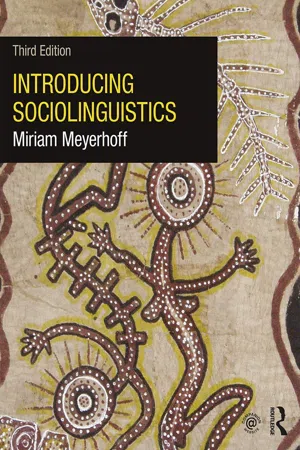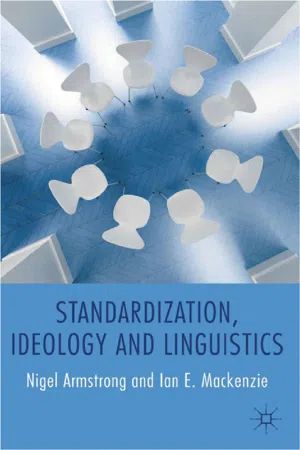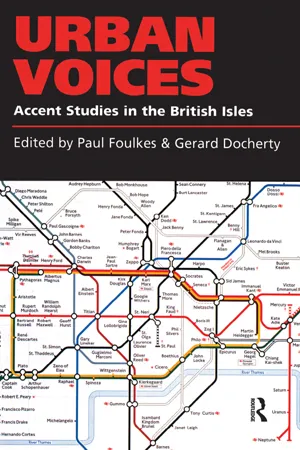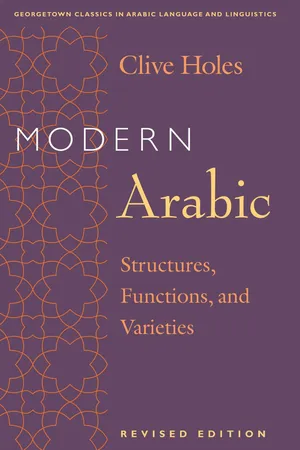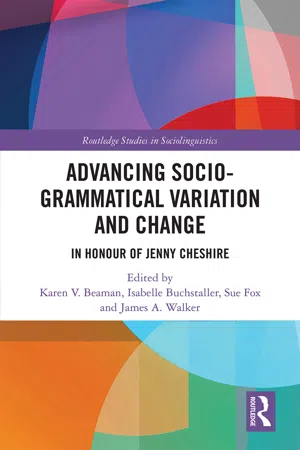Languages & Linguistics
Dialect Levelling
Dialect leveling refers to the process by which distinct regional dialects within a language become more similar to each other over time. This can occur due to increased communication and mobility, leading to the blending of linguistic features. As a result, the differences between dialects may diminish, ultimately leading to a more standardized form of the language.
Written by Perlego with AI-assistance
5 Key excerpts on "Dialect Levelling"
Learn about this page
Index pages curate the most relevant extracts from our library of academic textbooks. They’ve been created using an in-house natural language model (NLM), each adding context and meaning to key research topics.
- eBook - ePub
- Miriam Meyerhoff(Author)
- 2018(Publication Date)
- Routledge(Publisher)
This chapter will sometimes discuss cases of contact between different languages, and sometimes discuss contact between varieties of one language. Ultimately, it may prove to be the case that the same social and linguistic principles underlie all types of language contact and constrain the outcomes – whether between dialects or languages – but this remains an unanswered question at present. A lot of research is probing this question and hopefully, in the future, we will have a clearer picture of the important commonalities and differences associated with the outcomes of contact situations, depending on the different kinds of linguistic and social factors that went into the mix.Dialect LevellingDialect Levelling refers to the gradual erasure or loss of the differences that have traditionally distinguished very local or highly regionalised varieties of a language. It may or may not involve replacement of these distinctive features with new ones. As a rule, the process is the result of new or increased mobility of speakers, and many regional dialectologists and sociolinguists in Europe and Japan are studying the linguistic and social dimensions of the process. Researchers from these parts of the world are interested in Dialect Levelling because some of the social changes taking place in the twentieth century appear to be having a rapid and marked impact on the degree of local dialect diversity that has characterised these regions for hundreds (if not thousands) of years. Two related demographic phenomena are relevant: the mass migration of people to existing cities and the formation of New Towns.Dialect Levelling
Reduction of differences distinguishing regional dialects or accents. One possible outcome of contact between speakers of different varieties.Cities all over the world have seen enormous growth in the last 50 or so years. Burdett (2015) provides some visually striking graphics that show how fast the world’s large cities are growing (over time and per hour!). Some of the fastest growth has occurred in south and southeast Asia. The opening up of special economic zones (SEZ) in Southern China following the economic reforms of the 1980s has had a dramatic effect on that region. In some of the new cities, such as Shenzhen, the local population was rapidly outnumbered by migrants to the SEZ. Before 1980, Shenzhen’s population was 30,000; since the SEZ was established, it has soared to an estimated 20 million people (this includes the permanent and non-permanent residents in 2017). The vast majority of the arrivals since 1980 speak Mandarin, not the traditional Cantonese or Hakka varieties. Xu Daming has paved the way for serious sociolinguistic study of the new cities in Southern China (e.g., Xu 2017), but we still have comparatively little data on the outcomes of language contact there. - eBook - ePub
- N. Armstrong, I. Mackenzie(Authors)
- 2012(Publication Date)
- Palgrave Macmillan(Publisher)
Chapter 4 that internally motivated language change is essentially an analyst’s construct rather than a real phenomenon. If we are correct in that view, it potentially has implications for the dichotomy that Milroy invokes. In particular, it calls into question whether any linguistic change can be a matter purely of abstract or mechanical process, unmediated by factors that ultimately reflect the way language indexes beliefs and attitudes. We do not pursue the issue in detail here. Nevertheless, we do assume that, on occasion at least, Dialect Levelling may be an expression of an overarching phenomenon of social levelling or anti-standardization.The overall structure of this chapter is as follows. First, in Section 5.2, we attempt to contextualize the conceptual issues involved, focusing on certain methodological problems together with recent trends in cultural theory. In Section 5.3 we examine what we term ‘social levelling’, the erosion of previously well-entrenched hierarchies. In Section 5.4 we look in more detail at the linguistic manifestations of this process. And in Section 5.5 we present some concluding remarks.5.2 Contextualizing the debate
5.2.1 Methodological limitations
The nature of the social change we examine here can be referred to in various terms, perhaps the least problematic of which are ‘convergence’, or better, ‘levelling’. The term ‘levelling’ is more suitable as it seems to describe more accurately a symbolic diminution of social distance in certain respects, but without necessarily implying, as the term ‘convergence’ may, a concomitant increase in social cohesion or solidarity. Levelling in this sense seems more intuitively applicable to what we call below ‘vertical’ levelling. For clarity of exposition we distinguish below between regional (horizontal) and social (vertical) levelling, although as we shall see the two can hardly be separated in principle. We refer to ‘social’ levelling because the term ‘social’, as well as being a hyponym in this categorization, is also the superordinate since the term covers both the regional and (for example) social-class dimensions. Regional origin can most obviously be thought of in spatial or horizontal terms, as represented in Trudgill’s well-known pyramid (1995: 30) that relates the social (class) and regional components of UK accent variation. At the same time, the regional axis is ‘social’ in the sense that regional origin is an ascribed attribute possessed by virtually all speakers and capable of influencing social behaviour. - eBook - ePub
Urban Voices
Accent Studies in the British Isles
- Paul Foulkes, Gerard Docherty(Authors)
- 2014(Publication Date)
- Routledge(Publisher)
accent levelling, a process whereby differences between regional varieties are reduced, features which make varieties distinctive disappear, and new features emerge and are adopted by speakers over a wide geographical area (see also Cheshire, Edwards & Whittle 1993).Explanations for levelling have been sought in the changing demographic patterns of the last 40 years, which have seen an increase in geographical mobility: the populations of inner cities have declined as inhabitants move out to the suburbs and dormitory towns, while the populations of smaller towns and cities, such as Cambridge, Norwich, Ipswich, Reading and Oxford, have increased (Dorling & Atkins 1995; Giddens 1997). In addition, post-Second World War efforts to rehouse those displaced by the war or living in sub-standard accommodation in inner cities led to the creation of 35 ‘new towns’ across the country (Schaffer 1972). Evidence of an increase in social mobility is less clearly quantifiable but individual studies have shown a recent decrease in downward mobility, accompanied by an increase in the number of young men from blue-collar backgrounds taking up white-collar work (Marshall, Newby, Rose & Vogler 1988). Both vertical social mobility and lateral (geographical) mobility are likely to lead to the breakdown of the close-knit social networks associated with traditional working-class communities and thought to be influential in maintaining local linguistic norms (Milroy & Milroy 1992).The projects discussed here were designed to explore the links between such geographical and social factors and Dialect Levelling. The MK project was a study of the emergence of a new dialect in the new town of Milton Keynes (Kerswill 1994a, b, 1996a; Kerswill & Williams 2000). In the second (the DL project), three towns were chosen as research sites, similar in size but differing in their geographical location, demographic characteristics and social composition. The choice of town was informed by the claim that highly mobile populations give rise to diffuse social network structures which in turn promote rapid dialect change (Trudgill 1986, 1992, 1996b) and that the kind of stable communities we find in old-established urban populations promote the enforcement of local conventions and norms, including linguistic norms (L. Milroy 1987b). Milton Keynes, designated in 1967 and built on a green-field site adjacent to the Ml motorway, lies within an 80-kilometre radius of several important urban centres, including London, Oxford, Coventry, Leicester and Cambridge. It is Britain’s latest and fastest growing new town with a population that has increased from 40,000 in 1967 (MKDC 1990) to 176,000 by the time of the 1991 Census. Some 75% of the in-migrants to the town moved from other areas in the south-east, including London. In Milton Keynes, then, we have a socially fluid population made up of newcomers with aspirations to improve both their housing conditions and their employment prospects. Moreover, having arrived in the town, many residents continue to move within Milton Keynes itself (Williams & Kerswill 1997). Such instability hinders the formation of strong local ties and the kind of close-knit, stable social networks which reinforce linguistic norms and inhibit language change. - eBook - ePub
Modern Arabic
Structures, Functions, and Varieties, Revised Edition
- Clive Holes(Author)
- 2004(Publication Date)
- Georgetown University Press(Publisher)
The major finding of Blanc’s study, a landmark in the study of variation in Arabic, was that interdialectal conversation is subject to two tendencies: “classicizing” and “leveling.” “Leveling” refers to the tendency of speakers to eschew dialectal elements that are highly localized in favor of alternatives that have greater areal currency. This can affect all linguistic levels from phonology to lexicon, but it is particularly marked in the latter, the level of language structure at which speakers are themselves most conscious of dialect differences. A simple example will illustrate the principle. In a conversation between educated Arabs from the Gulf, Baghdad, Cairo, and Jerusalem, there are available to the speakers at least three dialectal ways of expressing “existential” ‘there’, as in ‘there are people who think …’, that are geographically distributed as follows:In this case, fi: is the variant likely to be used by all of the speakers because it has no association with any particular area and represents the nearest thing to a dialectal “common denominator” for this particular group. Speakers in a heterogeneous group tend to “level” their speech in the direction of what they recognize as a pan-Arab dialectal mean even if this sometimes involves, as it does here for the Iraqi, using a dialectal form that is not Iraqi at all. The preparedness of speakers to shift to dialectal forms that are not their own does vary, however. On the one hand, a Bahraini or Qatari would be most unlikely to use hast in a cross-dialectal situation because he or she might not even be understood by speakers from outside the Gulf, so localized is this word. On the other hand, Egyptians in particular seem much less inclined to shift away from Egyptianisms not found in other dialects, perhaps because of the dominant position that their dialect has established for itself over many decades in the educational systems and media of most Arab countries.32 We are here talking about “leveling” in a situation in which the dialects of the collocutors are markedly different from each other, but the same principle holds even where they are from less widely dispersed geographical areas. Speakers from less well-known or prestigious communities in a given country will tend to accommodate their speech to the dialect of a more prestigious area or group when the occasion demands, for example, peasants from the Nile Delta or Upper Egypt will make an effort to approximate to Cairene usage when they visit the capital; schoolchildren who use a “Bedouin” dialect with family will switch to an “urban” one at school.33 - eBook - ePub
Advancing Socio-grammatical Variation and Change
In Honour of Jenny Cheshire
- Karen V. Beaman, Isabelle Buchstaller, Susan Fox, James A. Walker, Karen V. Beaman, Isabelle Buchstaller, Sue Fox, James A. Walker(Authors)
- 2020(Publication Date)
- Routledge(Publisher)
Section 2 Combining the Social and the Grammatical 2.1 What Happened to Those Relatives from East Anglia? A Multilocality Analysis of Dialect Levelling in the Relative Marker System David Britain 2.1.1 Dialect Contact, Dialect Levelling, and Uneven Mobilities As a result of variationist and other dialectological investigations of language change over the last 30 years, evidence that England’s traditional dialects have been undergoing attrition has been emerging thick and fast (Britain 2009). Much of the evidence we have for this comes from studies of phonological variation and change, which have, amongst other things, highlighted the levelling of localised or marked variants, the emergence of new variants from contact between old ones, the regional (re)invigoration of regional forms or the geographical and social spread of innovative and/or unmarked and/or majority forms (Trudgill 1986; Kerswill and Williams 2000; Britain 2005, 2018). Foulkes and Docherty’s (1999) volume Urban Voices, for example, contains many case studies of such levelling across the British Isles and acted in many ways as a catalyst for others to track these changes in more places. It was generally agreed that one (if not the main) cause of these changes was mobility-induced dialect contact. One aim of some earlier work (Britain 2009, 2010) was to argue not just that such contact did indeed lead to levelling of traditional dialects, but that such mobility (bringing with it different ingredient language features into the local feature pool) was also the generator of new dialect forms and that mobility did not necessarily lead to an inevitable and unidirectional shrinking of dialect diversity but rather had the potential to increase such diversity as well. This has been best demonstrated in recent years by the large London English projects conducted by Jenny Cheshire, Paul Kerswill, Sue Fox, and Eivind Torgersen (e.g., Cheshire et al
